Table of Contents
Importance of killing mosquito larvae in standing water
Mosquito breeds in stagnant water by laying eggs and these eggs hatches into larvae. This is the stage where the mosquito babies are concentrated at one place and can be easily targeted as com pared to adult mosquitoes. Where we have to use different sprays and chemicals, just to repel them away for the sake of our comfort.
Once these mosquito larvae are allowed to develop in to adult mosquitoes, they will lay more eggs and breed in more larger numbers. So, reducing their population at this larval stage itself is of prime importance.
There are many critical and major problems which should be considered and addressed at the early stages of mosquito infestation. Killing mosquito larvae in water is prominent and more advisable due to:
1. Prevention of Mosquito-borne diseases
Mosquitoes are known for carrying and transmitting many dangerous diseases like Malaria, Dengue, Chikungunya, Zika virus, West Nile virus, etc. If we target the mosquito larvae, will be able to reduce the adult mosquito population and thus can reduce the danger from these diseases.
2. Effective solution for mosquito population control
Since these mosquito larvae are confined and concentrated at one place being immobile, they can be easily targeted and killed all at one place. The adult mosquitoes are in the open sky and highly mobile so its not possible to follow them all around.
3. Reduction in usage of toxic harmful chemicals
The many kinds of insecticidal sprays and harmful chemicals, that are being used to repel mosquitoes and pest control, their usage can be reduced to a minimum, by restricting their growth at larval stage. And thus, killing mosquito larvae is more environmental friendly approach.
4. Cost effective solution
By attacking the larvae at confined locations, we will be using fewer resources as compared to adult mosquitoes where more stringent and expensive control measures are required.
5. Improved quality of life
The mosquito threat adversely affects our daily routine and restricts our outdoor activities. We can’t enjoy outside, no outdoor gatherings and it is scary to step outside and are forced to live in our houses and living space. Thus, if there are no mosquitoes it means improved quality of life.
Killing mosquito larvae in standing water is an effective and most feasible method to get rid of mosquitoes. If neglected, can increase the population to a greater extent, that will be not possible to fight against without any major control program which may cover entire city. Such kind of situation will bring immense threat from mosquito borne diseases and even going outdoors will not be possible.
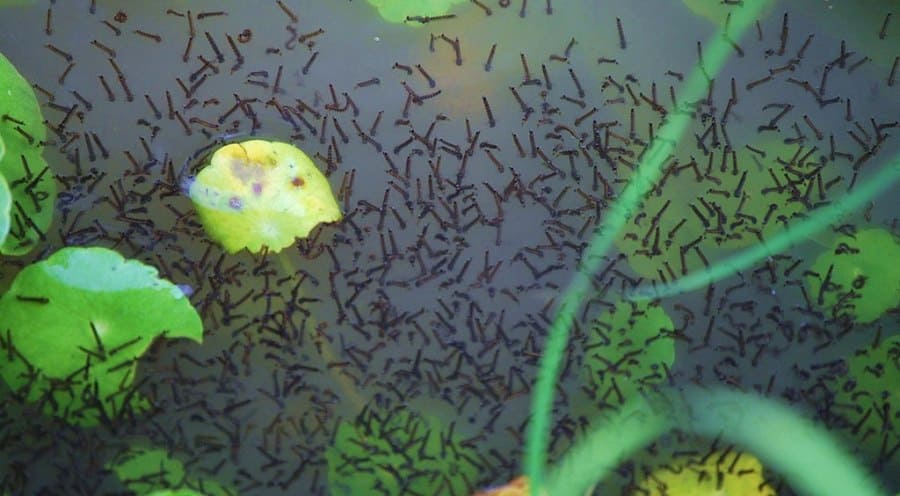
Image Credit: Wikimedia by Mary Hollinger, NOAA/NESDIS/NODC | Content License
How to kill mosquito larvae in standing water?
The mosquito eggs hatches into larvae, the second stage of mosquito development. These mosquito larvae are confined and concentrated in standing water bodies, and are generally immobile. However, they need to come upwards on water surface frequently to get oxygen. There are many methods used to kill mosquito larvae which disrupts their development and growth in water.
We generally have to add certain chemicals or bacteria that will do cellular damage to the larvae. You can also, create highly acidic environment which is inhospitable for them. There are certain natural bacteria based larvicides which kills the larvae without damaging other aquatic life. There are certain fish and birds and even insects, that feed on mosquito larvae.
Thus, we can use different known possible chemicals and household things to kill mosquito larvae in standing water. How we can use and what will be the method for each that kills mosquito larvae in standing water, is explained below.
What Kills Mosquito Larvae in Standing Water?
As per the size, location and volume of water body, there are different methods used that attacks mosquito growth and development. These methods can be effective but expensive, or can be cheap but not safe. All points should be considered before making any decision. The methods which are being commercially and practically used are gathered at one place and explained below for a better understanding.
11 Methods that kills mosquito larvae in standing water
The following methods are used as per the size and volume of standing water and environmental conditions as well:
1. BTI (Bacillus Thuringiensis Israelensis):
BTI is an highly effective naturally available bacterium that kills specifically mosquito larvae in water, without any damage to other aquatic life. The BTI releases toxins that damages the digestive system of larvae, leading to their death. It is safe to use in ponds, bird baths, water tanks as there is no harmful effects on humans, pets, birds and aquatic life. It is available in form of tablets or granules and liquid solutions, and can be easily used in recommended dosage as per volume of water in the water body.
Just add the tablets in water or sprinkle the granules on the water surface and BTI will start its action in no time. BTI remains effective for around 30 days but after heavy rains or if the larvae population is more than you may need to reapply, or increase the dosage.
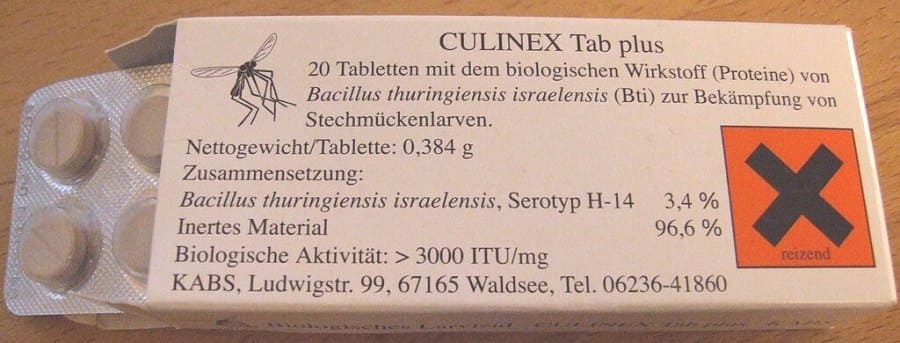
Image Credit: Wikimedia by Claus Ableiter | Content License
2. BS (Bacillus Sphaericus):
These are also similar to BTI and they also attacks the digestive system of larvae. Once these bacteria are ingested inside the larvae, they releases toxins which damage the gut lining of the larval gut. Later due to inability to process food and starvation, they die.
They can also be applied in the same manner as BTI, and are also available in tablets, or granular form.
3. Methoprene:
Methoprene is an Insect Growth Regulator (IGR). It mimics the hormone inside the insects that is responsible for their growth and development. When methoprene is used as larvicide, it disrupts the natural molting process of mosquito larvae and prevents them from developing into a pupa. Thus, the larvae dies before it reaches the pupal stage.
Methoprene is available in many different forms like granules, briquettes, pellets, liquid etc. Different forms allows us to use it for different applications. In commercial methoprene, the active concentration varies from 1.5% to 20%.
Granules are used in damp areas, marshy soil and puddles. It ensures even coverage of the surface due to its granular form. While pellets or tablets can be added to small standing water bodies like small pond, bird baths, water features, etc.
Liquid form required to be diluted first and then needs to be prepared either a diluted solution for direct mixing or as a spray solution for spraying. This spray again ensures even coverage of surface like marshy soil or puddles.
4. Predators like Fish:
Mosquito fish, as they are generally known or Gambusia affinis, are fresh water fish. They are known for eating mosquito larvae from water bodies. They are purposely incorporated in many mosquito control programs to control the mosquito population at early stages.
These mosquito fish ferociously feed on mosquito larvae and pupae, and effectively controls their population. It is a chemical free, biological control method and quiet effective.
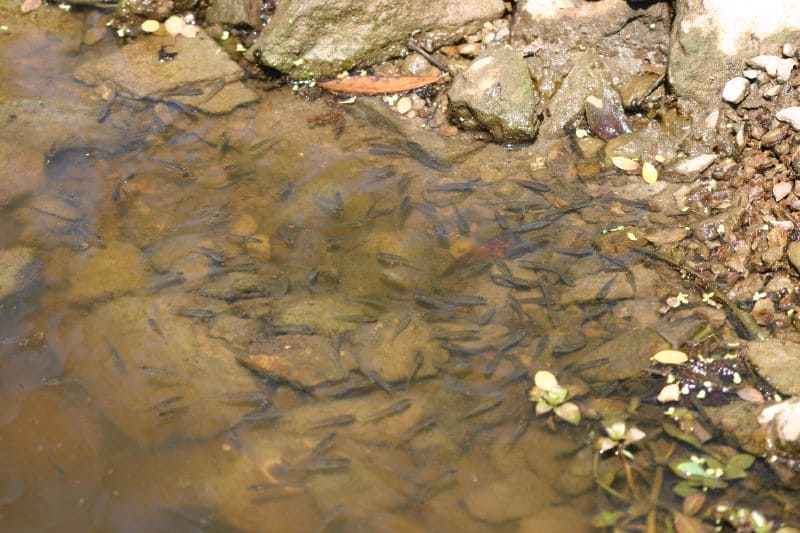
Image Credit: Wikimedia by Clinton & Charles Robertson | Content License
Gold fish, are also known for its ability to control mosquito larvae population. Can be added in your backyard pond or water features in garden. They will feed on all kinds of insects in water including larvae.
Not much maintenance is required once they are introduced to the water bodies, and it will give ongoing control over mosquito larvae as long as the water bodies condition is favorable for their survival. Check regularly for any algal growth, their sizes which may grow bigger with time, and their stocking density as per the larvae present. We should also consider for proper space they needed and their oxygen requirements.
5. White Vinegar:
White vinegar is effectively used as homemade solution for mosquito larvae. This is very effective in small water bodies like, bird baths, puddles, or water containers, etc. where there is no other aquatic animals that can be harmed. As the vinegar will create acidic environment around pH 3 to 4, where larvae undergoes cellular damage and they get die.
Add white vinegar after diluting it to around 1:4 ratio to small waters like containers, toilet bowls, etc. Make sure to cover all the surface of the water, and allow 1hr for the action. The larvae will start dying off soon. You can also add some dish wash soap to prevent them from coming to surface for oxygen.
For larger water bodies, vinegar is not practical to use, to maintain the highly acidic pH as very high quantity of vinegar will be required and it may harm severely to other aquatic animals in the water body. Also, make sure you are not using near surfaces with marbles and tiles. This will corrode and damage the surface due to high acidity.
6. Mosquito Dunks:
Mosquito dunks are donut shaped hard pieces containing specific bacterium, BTI (Bacillus Thuringiensis Israelensis). The mosquito dunks are designed biological product which releases slowly and gradually the active bacterium. This in return slowly attacks specifically the mosquito larvae only, without harming other aquatic animals and insects. The mosquito dunks can carryout its larvae control action for 30 days. After which it may need to be added again.
One dunk can be used for 100 square feet, nearly several gallons of water. Follow manufacturers instructions on dosage and reapplication conditions. usually after heavy rainfall or peak breeding season, you must consider reapplying.
The mosquito dunks can be used at places like backyard ponds, water features or fountains, bird baths, rain barrels, water septic tanks, etc.
They are safe for plants, fish and other aquatic animals. No extra efforts are required while applying and very easy to use. Keep a note that its effectiveness reduces in water where large water movements are there. It’s very effective in stagnant water without any movement.
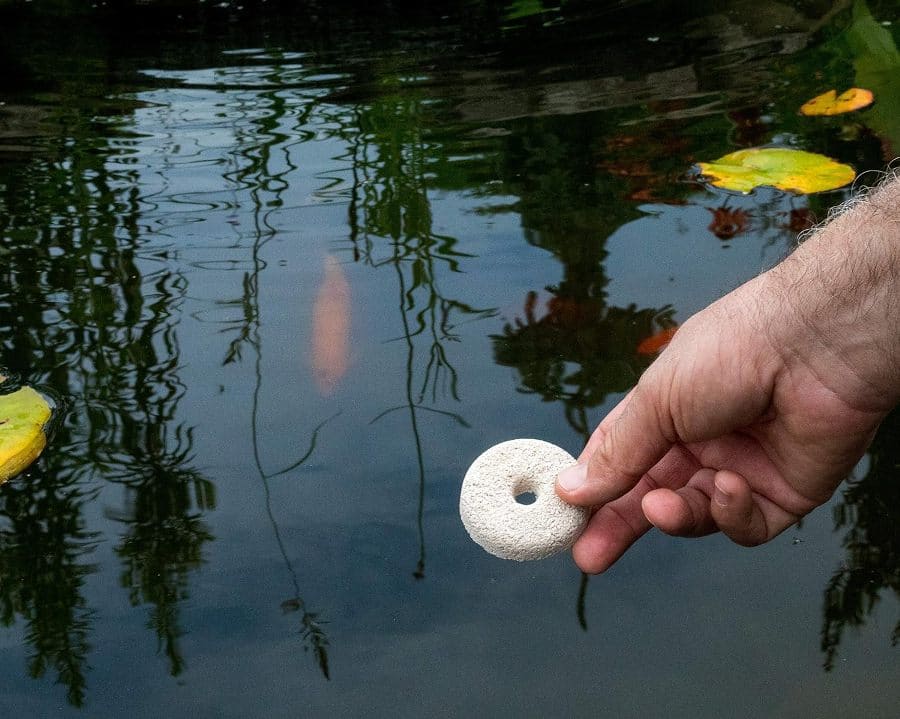
Image Credit: Amazon.in
7. Chlorine Bleach:
Use of chlorine bleach is a chemical method to kill mosquito larvae. It is a strong oxidizing agent that damages the cellular structure of larvae, leading to their death. Since, the use of chlorine contaminates the water and its harmful for other insects and pets at home. Also, the chlorine fumes are highly dangerous for our respiratory system. Should take additional precautionary measures like gloves and masks, while using chlorine bleach.
A very dilute solution of chlorine bleach around 1 table spoon (15ml) in a gallon (3.8ltr) of water to be treated. This diluted concentration will have minimum effect on other organisms sand insects around.
Add the bleach solution directly into the standing water. Mix it thoroughly and evenly distribute the solution in the water. Allow sufficient time, at least 30 mins for bleach to kill the larvae.
Avoid using bleach to ponds, water features, bird baths, etc. where other animals and insects will get harmed. Only use in controlled environments like swimming pool, drainages and gutters, small containers, etc. where it can be drained or disposed off easily.
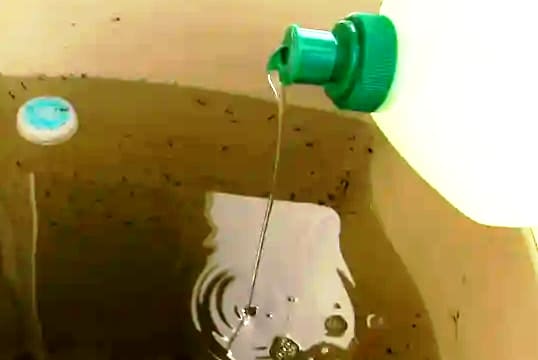
Image Credit: MosquiTalk.com
8. Dish Soap or shampoo:
Dish soap or shampoo can sufficiently reduces the surface tension of water, which causes larvae to sink and drown. They mostly align themselves near the water surface with their tail upwards, to access oxygen from the air outside water.
The reduced surface tension, hinders their swimming capability and they get sink to the bottom. Without oxygen they can’t complete their development process and they die soon. Just a small quantity of dish soap or shampoo per gallon of water is sufficient to treat larvae infested water.
This too is a chemical based treatment, not too stringent but it may harm other beneficial aquatic plants and animals. So, it should be used for small water bodies like bird baths, flower pots, containers, etc.
9. Phenyl:
Using Phenyl which is a disinfectant, is again a chemical treatment. When added to standing water it creates a toxic environment that leads to suffocation and affects the breathing process among larvae.
Phenyl can be used in small water bodies like drainage systems, gutters, puddles and marshy land, etc. Because of its toxic nature it should be used in smaller quantities and should be kept away from kids and pets.
10. Vegetable oil / Mineral Oil:
Oil always floats on water due to its density, as it is lighter than water. When oil is added to standing water, it forms a thin layer all over the water surface. This oil layer blocks the oxygen which is necessary for larval growth. Once their access to oxygen is restricted due this oil layer which acts as a barrier, they suffocate and can’t live without oxygen.
Although it is not that harmful, but it can be dangerous for other aquatic animals in the water as they too need oxygen for their survival.
11. Salt:
Salt is the cheapest and simplest of all, as this is water soluble and does not harm to kids and pets. Salt when added to standing water, it increases the salinity and which disturbs the osmotic balance inside the body of larvae, causing them to dehydrate and eventually leads to death. However it may harm other organisms within the water body, but somewhat on safer side as it is non-toxic.
The concentration of salt must be high to create sufficient salinity to be effective, around 1-2 table spoons of salt to be used per gallon of standing water. Such quantities of salt when added to larger water bodies, can affect the ecosystem and so should be used proactively.
Conclusion
Killing mosquito larvae in standing water is important to avoid transmission of diseases like malaria, dengue, etc. The only effective way to prevent such diseases from spreading is to break the mosquito life cycle. And so killing larvae is the most effective option to get control over the mosquito population, because as long as mosquito live they will breed and rise with their population in numbers that we can’t imagine.
There are many biological methods like using BTI, BS, etc. as well as chemical methods like Methoprene, Chlorine bleach, etc. all are having different effectiveness against larvae. We can also try stocking predators like mosquito fish, gold fish, mosquito hawks, etc.
Later, there are more safer and cost-effective methods that are categorized as home remedies for mosquito larvae, such as, white vinegar, dish soap or shampoo, vegetable oil/mineral oil, salt etc.
Frequently Asked Questions (FAQs)
-
How do you kill mosquito larvae in water tank?
If the tank is smaller you can use methods like vinegar or chlorine bleach, which is cost effective. You can use mosquito dunks which is very much effective but comparatively expensive too. If the water tank is large enough, than you can go for using BTI or BS that will give much better protection from mosquito larvae.
-
What are natural predators that i can use in my backyard pond?
You can use mosquito fish (Gambusia) and gold fish feeds on mosquito larvae and other insects in water. You can stock these fish in your pond to reduce the mosquito larvae population.
-
Can I use salt to kill mosquito larvae in standing water?
Salt increases the salinity of water enough to create an environment which is not good for mosquito larvae. The salt affects the osmotic balance inside the larvae, causing dehydration and eventual death.
-
What are mosquito dunks?
Mosquito dunks are donut shaped pellets that are used in larval control in standing water bodies. This releases BTI (Bacillus Thuringiensis Israelensis) slowly and gradually, which kills the mosquito larvae. These are added to standing waters and without any further efforts they kill all mosquito larvae. They lasts up to 30 days and then it should be added fresh again.

